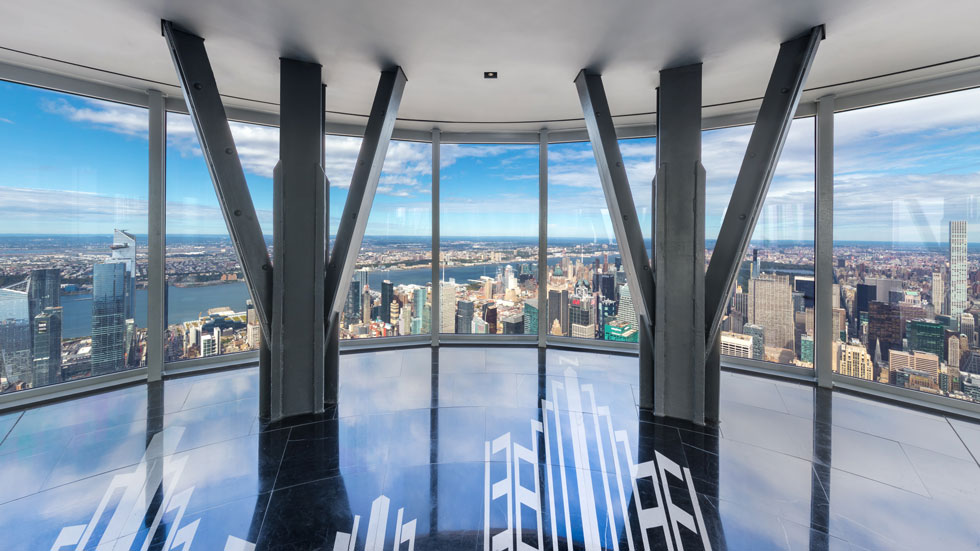Empire State Realty Trust says it is a great way to bet on New York City.
New York City is busy again, and that’s music to the ears of Empire State Realty Trust, Inc. (NYSE: ESRT), who says its portfolio of office, tourism, retail, and residential assets in Manhattan and the greater New York metropolitan area offers multiple drivers of upside.
The REIT’s fully modernized, amenity-rich assets incorporate its industry-leading sustainability, energy efficiency, and indoor environmental quality at attractive prices—well below new construction—and are designed to be the accessible, “flight to quality” destination in the market. A string of expansions and new leases from reputable tenants like LinkedIn, iCapital, Signature Bank and Progyny suggest that ESRT has the right idea.
Evercore ISI is optimistic. “While the office sector remains challenged, the recovery of lost occupancy and observatory net operating income (NOI) provides ESRT with a roadmap to solid earnings growth over the next few years,” the firm wrote in a client note earlier this year.
ESRT held its IPO in 2013 after a consolidation of dozens of partnerships and sub-partnerships created by Lawrence Wien, son-in-law Peter Malkin, and current Chair, President, and CEO Anthony Malkin.
The company owns and manages office, retail and residential properties that include 9.2 million square feet of rentable office space, 700,000 square feet of retail, and 625 recently acquired multifamily units. It is perhaps best known as the owner of the Empire State Building, a 2.85 million-square-foot landmark finished in 1931 that includes the world-famous Observatory, which was recently named the number one attraction in the United States and number three in the world in Tripadvisor’s 2022 Top Attractions. Through a combination of aggressive on-property actions and offsets, the entire commercial portfolio is carbon neutral as of 2022, and the company maintains aggressive on-property emissions reduction goals for 2030 and 2035.
“We are a play on New York City,” says Anthony Malkin.
Never Waste A Crisis
Despite past challenges and the operating environment ahead, ESRT is optimistic. The REIT has a laser-focused strategy on its key objectives, which include leasing space, boosting income from the Observatory, and maintaining its leadership in sustainability, along with actions it believes will continuously enhance shareholder value. “We never waste a crisis,” Malkin says.
Malkin took on more responsibility at the height of the pandemic in 2020 as chairman, president, and CEO. ESRT’s EVP and CFO Christina Chiu—who had previously spent nearly two decades with Morgan Stanley, most recently as COO for the global listed real assets division—was hired at the height of the pandemic in 2020. As Green Street wrote at the time, “the reshuffling of the C-suite appears to set the stage for a new period for ESRT.”
Chiu says the company offers “multiple avenues to play the upside that is underway in New York City.” She adds that the REIT has a flexible balance sheet with a low level of debt, substantially all of which is fixed rate, and a compilation of assets “that we believe are extremely well-positioned entering into what is an uncertain environment.”
The looming uncertainly is nothing like what occurred as the recent pandemic swept the globe and forced many office tenants to temporarily shutter their spaces. The REIT also had to close the Empire State Building’s lucrative Observatory business for several months during the pandemic, during which time it revamped its operations to an all-reservations model and has led to far greater profitability and customer satisfaction.
Flight to Quality Destinations
ESRT benefits from the market’s flight to quality with its retrofitted, fully modernized, healthy, energy-efficient buildings that offer attractive amenities at an accessible price point, with most of its portfolio located within a nine-minute walk to primary transportation hubs.
Since the IPO, nearly $1 billion has been spent on the redevelopment of the portfolio, Malkin says. The buildings make quality “accessible to a broad range of tenants, not just the ones that can afford or want to pay $150 (per square foot) rents in brand new buildings,” he adds.
ESRT’s well-positioned portfolio delivers modern, in-demand spaces at accessible rents. ESRT pioneered tenant amenities with the Empire State Building’s 16,000 square foot tenants-only fitness center, conference center, and a comprehensive set of in-building dining options. The Empire State Building will add a new, tenant-only amenity space to include a basketball court that converts into an all hands meeting space for 400 plus, a lounge, food and bar service, and “ESRTees,” a reservable lounge with two golf simulators. According to the company, these new amenities will be constructed in a “unique concourse-level space with vaulted ceilings.”
The company also announced plans to add new amenities to its Broadway Campus—comprised of six buildings in close proximity—which will include a roof deck on 1333 Broadway and an all-hands meeting space at 1400 Broadway, both of which will be available to all tenants of its Broadway portfolio.
In the second quarter, the company’s NYC office portfolio was 88.3% leased, with tenants from a wide variety of sectors that include: technology, media, and advertising (21%); finance, insurance, and real estate (20%); and consumer goods (19%).
“Our Tenants Really Like What We Offer”
Tenants frequently grow within the portfolio, with more than two million square feet of expansion leases signed by existing tenants in less than a decade of public ownership. While many industry watchers wonder how the work-from-home trend will affect property owners long-term, ESRT invalidates those concerns with a flurry of recent leases and expansions that demonstrate tenants continue to enter long term commitments for high quality space.
LinkedIn now leases more than 600,000 square feet at the Empire State Building on a long-term lease, which makes it the largest tenant that contributes 5% of the portfolio’s annualized rent.
Signature Bank now has 11 floors at 1400 Broadway that total 313,109 square feet through multiple expansions. iCapital, a global fintech company, has grown multiple times at One Grand Central Place since its first 17,573 square foot space was signed in 2017, and now boasts a footprint of 123,651 square feet, according to the company. Burlington Stores Inc. signed a full-floor expansion for an additional 35,000 square feet of office space at 1400 Broadway in Manhattan. In Connecticut, Franklin Templeton, a global investment management organization, renewed its lease for 80,000 square feet at 100 First Stamford Place, representing about 10% of the complex’s square footage.
As mentioned by Malkin on the company’s second quarter conference call, “2.2 million square feet of expansions in our portfolio since October 2013 – I don’t think that’s a coincidence. It means that our tenants really like what we offer. The price point is good and we choose our tenants well and that’s a benefit.”
“We absolutely believe in New York City. We feel very privileged to have the portfolio we have and the fact that we are in New York City.”
Early and Ongoing Sustainability Leadership
ESRT was a decade early in its focus on sustainability and healthy buildings, long before they became the key tenant priorities they are today.
Under Malkin’s leadership and vision, the company has cut carbon emissions for its portfolio by more than 40% since 2009 and works to ‘future proof’ its assets with investments in the necessary upgrades for tomorrow. Since 2009, long before ESG became a widely used acronym, ESRT has specifically reduced emissions at the Empire State Building by more than 54% and energy use by more than 40%. The portfolio’s tenants can literally breathe easier, the company says, particularly in the “IEQ Suites” which offer active bi-polar ionization, access to natural light, and low/no volatile organic compounds (VOC) materials.
The company was one of only nine awardees to receive Green Lease Leader Platinum by the U.S. Department of Energy’s Better Buildings Alliance and the Institute for Market Transformation. The award recognizes ESRT’s industry-leading integration of high-performance leasing and sustainability practices into business operations to deliver energy efficiency, cost savings, air quality, and sustainability for tenants. This specific achievement communicates to ESRT tenants and prospects that they can achieve long-term goals for carbon neutrality, Local Law 97 compliance, and return to the office in a healthy building just because they chose an ESRT property.
In April of this year, a coalition of New York City property owners, spearheaded by ESRT and supported by other NYC-based landlords, launched a blueprint to push commercial buildings around the country to achieve double-digit reductions in energy use and carbon emissions at commercially acceptable returns.
Known as the “Empire Building Playbook: An Owner’s Guide to Low Carbon Retrofits,” it was co-developed with the New York State Energy Research and Development Authority (NYSERDA) and supported by the Clinton Global Initiative. President Bill Clinton, Governor Kathy Hochul, and Mayor Eric Adams visited the Empire State Building Observatory for a special press conference to back the initiative for the official launch on April 21.
Clinton stated at the event, “(ESRT) has always been willing to share everything about how the Empire State Building and now all the related buildings achieved the savings they’ve achieved, how many jobs were created, how much their power bills go down, how much benefit ordinary people get. Now you get it in one place, nobody has an excuse anymore.”
The retrofit of the Empire State Building served as the initial blueprint for the Playbook, as it highlighted the fact that older buildings could be modernized to meet the highest sustainability demands of today. “We’re recognized as absolute leaders in this area,” Malkin says.
The Empire State Building’s elevators generate energy as they move, while thousands of windowpanes were refurbished on site to be ultra-insulated. ESRT transformed the building’s lighting system, which included an adaptive dimming system that adjusts according to light coming in from the outside. As a result, the building has reduced greenhouse gas emissions and become a symbol for what is possible around deep energy retrofits.
Everyday Retail With National Tenants
The company’s “everyday retail portfolio” features national tenants that make up 95% of the revenue from the company’s 700,000 square feet of retail space thanks to its highly trafficked locations in dense areas.
A 23,000 square-foot, three-floor Starbucks Reserve is set to open this year in the Empire State Building along with a Target at 10 Union Square East, the retailer’s second location in the ESRT portfolio.
Cosmetics giant Sephora, the largest retail tenant in terms of annualized rent with more than 11,000 square feet, and Urban Outfitters with 57,000 square feet, both have leases that extend to the end of the decade.
“As a company, we’re forward-leaning and we have to think about the future, our strategy, what we are, and how we add value for shareholders.”
The Reimagined Observatory
While it’s not unusual for a REIT to own a landmark property, ESRT owns the World’s Most Famous—the Empire State Building and its award-winning Observatory Experience. The Observatory recently completed a $165 million redevelopment that includes a new, dedicated entrance, as well as an interactive experience that takes guests through a full museum of exhibits that showcase the building’s history from construction to current place in pop culture.
The attraction is a key contributor to income, helped by the fact that it was awarded Tripadvisor’s number one attraction in the U.S. and number three in the world. It is Uber’s most popular destination in the world.
When the business was forced to close due to the pandemic, Malkin says the company took the opportunity to become a reservation-only attraction. The new ticketing system smooths the flow of tourists and prevents lines and delays, the number one source of complaints prior to its institution, Malkin says.
Reservations allow the Observatory to utilize dynamic pricing during sunset, the most popular time due to the stunning views. The change in operations model has paid off: For the second quarter of 2022, while visitors remained at 60% of what they once were before the pandemic, net operating income recovered to 80%. “Now people don’t have to wait in line, and we deliver a better experience,” Malkin says.
Local Sharpshooter
In an off-market transaction, ESRT recently concluded a $307 million recapitalization with the Fetner Organization through which it garnered a 90% share of two multifamily properties. According to Chiu and Malkin, this is not a move that may seem to take it away from its core business, rather to increase its concentration on value drivers that benefit from the recovery of the Big Apple.
One property, The Victory, includes 417 units on 45 floors at 561 10th Avenue, an area known as Midtown West near Hudson Yards. At 345 E 94th Street, there are 208 units on 30 floors. ESRT touts this as an inflation-protection play that benefits from New York City’s demand recovery for residential buildings that are well-located, well-amenitized, and currently more than 95% occupied.
The move could seem unusual in REITland, where investors generally seek simplicity, but Chiu is undaunted and has stated that the move is a natural one for ESRT and adds value for shareholders. Both she and Malkin agree that additional apartment purchases will be done when it makes sense.
“We Absolutely Believe In New York City”
“As a company, we’re forward-leaning and we have to think about the future, our strategy, what we are, and how we add value for shareholders,” Chiu says. “In essence, ESRT is a New York City local sharpshooter.”
Blaine Heck, an analyst with Wells Fargo, says ESRT is operating in a “difficult segment of the commercial real estate market as the return to office has lagged many forecasts, and newly constructed office buildings have been added to the inventory in New York throughout the pandemic.”
That said, “ESRT has seen encouraging leasing activity at several of its properties, likely as a result of the significant capital spent on redeveloping their office assets,” he adds.
Overall, the REIT is comfortable with its New York City focus. “We absolutely believe in New York City. We feel very privileged to have the portfolio we have and the fact that we are in New York City. We also feel very privileged that we’re part of a dynamic cultural environment where people want to come to work,” Malkin says.
“You ask people where they want to go when they come out of college, and a majority of them still say ‘New York City.’ For us, it’s just a question of, ‘What’s the right way to play it?’ ‘What’s the best way to succeed?’” Malkin adds.


